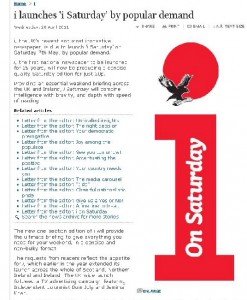In 2003 he oversaw the redesign of the paper in compact form, an innovation so successful that other major British dailies followed suit. And last year he presided over the launch of i, a lower-priced digest of stories from The Independent targeted at on-the-go readers.
Kelner is due to talk at the World Editors Forum in Vienna (12-15 October) about how editorial initiatives can contribute to print success.
WAN-IFRA: i was launched last October. Nine months on, how would you rate its success?
KELNER: It’s been a tremendous success. The circulation sales followed the normal trajectory of a launch – very high at the start and then slowly came down to a very healthy level. But then we came back at the start of this year with a big advertising campaign and sales have continued to grow ever since then. Now we’re selling around about 180,000 a day.
WAN-IFRA: Do you think having smaller, cheaper editions that synthesize the news is something that will catch on with other dailies?
KELNER: I think it has given a lot of newspaper organisations pause for thought, the idea that you could launch a new printed product that gave people what they wanted at an affordable price, as you say synthesizing the material that you already produce. And it’s successful.
WAN-IFRA: How do reader profiles of i compare to those of The Independent?
KELNER: i has a younger more metropolitan readership. It’s a newspaper that was targeted at a young, mobile commuter-focused audience.
WAN-IFRA: Maybe something more like The Evening Standard or The Metro?
KELNER: It’s much more up-market than The Metro. And obviously The Metro’s free and i has a cover price. But it’s targeted at people who are on the move, who have busy lifestyles and i fits into their profile.
WAN-IFRA: i is only 20p, a fifth of the price of the Independent. If it proves too successful, could that be a threat to profitability?
KELNER: No. One of the very encouraging things ever since i has launched is that it hasn’t cannibalised the sales of The Independent too much. And the same is true of other quality papers as well. It’s definitely grown the market in terms of quality readership.
 i on SaturdayWAN-IFRA: In April i expanded with a Saturday edition - how have readers responded?
i on SaturdayWAN-IFRA: In April i expanded with a Saturday edition - how have readers responded?
KELNER: We only launched the Saturday edition in response to reader demand. It [i] was launched originally as a Monday-to-Friday product. We’ve responded to the needs of our readers all the way along, in small ways and in quite large ways. And obviously launching the Saturday was quite a major thing for us, but it was very much in response to what readers wanted. And they’ve supported it and we’re very, very pleased with the level of sales on the Saturday.
WAN-IFRA: Marketing and promotion played a major role in the success of launching i... how do you think newspapers can better market their print products?
KELNER: I think what i proved is that if you have a product that meets a need in the market and you have marketing that communicates what is the proposition of the product then it’s the formula for a success.
WAN-IFRA: So it has to come from two directions. It’s not just about marketing, it’s about getting the product right at the beginning?
KELNER: You can have the best marketing in the world and if the product doesn’t meet the needs of the audience you’re not going to do very well. What we started off with was assessing what the needs of the audience were and then directing a product very much at those needs.
WAN-IFRA: In 2003 you were named Editor Of The Year at the 'What the Papers Say' awards, and the judges commented, among other things, on your 'arresting front page designs'. What's important on front page?
KELNER: Well the front page is your shop window really and it’s the best bit of marketing communication that you can put before the public. So if you’re editing a paper everything’s important, the comment pages, the sports pages, but the front page is the most important of all because a lot of our sale comes from casual purchase and if you can arrest people’s attention at the newsagents where there’s all those other products then you’re halfway there.
WAN-IFRA: With nearly 2 million copies of the News of the World off the stands now, will quality papers try to fill some of that void?
KELNER: I think we’ve seen that, since the News of the World has gone, a lot of sales have gone to their direct competitors like the Sunday Mirror and the People and The Star. I think a lot of quality newspaper readers bought the News of the World but they bought it in addition to a quality paper so I’m not sure that there’s much for us to gain by the demise of the News of the World.





